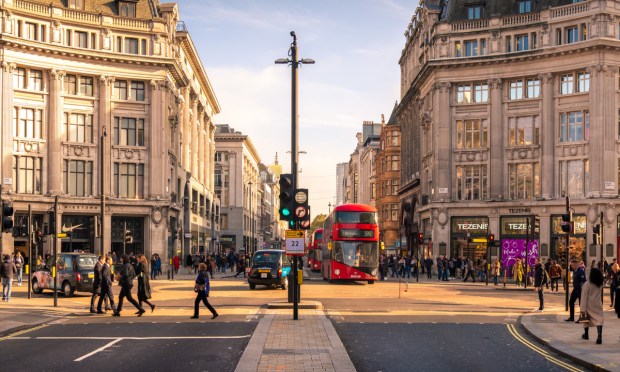As Hybrid Work Impacts Urban Retail, London Looks to Offer Rent-Free Shops

During the pandemic, many fled the city to live the suburban life. Today, urban commercial real estate companies are struggling to fill their spaces with enticing retailers that will encourage consumer foot traffic.
Some, however, are willing to make bold bets by bucking the eCommerce trend and opening physical stores, even despite the projection of demand for office and retail space in major urban cities staying below pre-pandemic levels.
Certain companies have acknowledged the significance of face-to-face interactions and personalized consumer experiences. For example, SKIMS by Kim Kardashian has effectively used shop-in-store experiences and pop-ups to explore diverse markets. As a result of these efforts, the brand is preparing to launch its first permanent stores.
Read more: Kim Kardashian’s Skims Captures $4 Billion Valuation
Other brands to bet on physical retail include Abercrombie & Fitch and New Balance.
Read more: Retailers Embrace Immersive Storytelling to Woo Fickle Consumers
However, in the U.K., in a joint effort, the Westminster City Council and New West End Company are looking to breathe life into London’s Oxford Street shopping scene by supporting small businesses. They are offering rent-free shop spaces to these enterprises, encouraging them to showcase their creativity and bring something unique to add vibrancy to the shopping district.
Dubbed “Meanwhile On: Oxford Street,” the initiative is an extension of previous pilot programs in the area, focusing on providing temporary pop-up spaces to businesses. The project is inviting businesses to establish their inaugural store or physical presence.
“The West End has recovered quickly from the pandemic, but there are still too many vacant units and poor-quality occupants. That’s why we’ve set up ‘Meanwhile On: Oxford Street’ to help fill the gaps with upcoming brands showcasing their innovative new ideas,” said Councillor Geoff Barraclough, cabinet member for planning and economic development. “I am excited to welcome new brands to one of the most famous streets in Europe and support them with free rent, reduced business rates, and help with promoting their businesses.”
Selected brands will be offered prominent store locations for an initial six-month period, using spaces formerly occupied by less-popular tenants, like American candy stores. This step is aimed at elevating the overall shopping experience on the street.
Through this scheme, chosen businesses will receive a 70% reduction in business rates and gain access to support services, including assistance with store design, mentorship, management and marketing.
The program’s objective is to onboard approximately 35 brands within the next three years, starting this autumn. They are seeking applications from “innovative and up-and-coming small businesses that can offer something unique to customers in terms of products, events, experience, or concept.”
According to the Westminster Council, the chosen businesses are encouraged to explore technologies like virtual or augmented reality, organizing interactive exhibitions, and showcasing the production process directly within the store. For instance, they may set up on-site machines to demonstrate the crafting of clothes and other goods.
The initiative will provide a range of store sizes, catering to various business needs. These spaces can be used for individual tenancy, where a single brand occupies the entire store, or as creative curated themed concept stores shared between multiple brands that align with the chosen theme.
Rethinking Urban Commercial Real Estate
Urban commercial real estate needs to dig deep into the opportunity they bring, because one major thing working against them is lack of foot traffic.
During the pandemic, with remote work becoming the new norm, there was a notable migration of households away from the urban cores. New York City’s urban core population declined 5% from mid-2020 to mid-2022, San Francisco’s fell 6%, and London’s lost 7% from mid-2020 to mid-2021.
Meanwhile, in the suburbs, populations either grew or declined less. In the U.S., suburbanization was already underway before the pandemic, and the shock from the pandemic accelerated this trend. In contrast, in most of the European and Japanese cities examined in a study, urbanization was replaced by a shift to suburbanization.
In addition, urban stores witnessed a drop in consumer spending.
Fast forward to today, employees continue to dedicate significantly less time to working at the office. As of October 2022, office workers were visiting the office about 3.5 days per week, though this figure varied across different cities. For instance, in London, it was around 3.1 days per week, while in Beijing, it was about 3.9 days per week.
